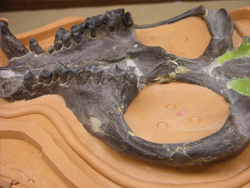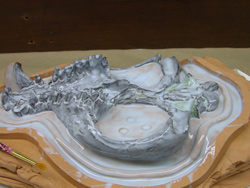Molding and Casting

Molds are made from fossils in order to make reproductions of the fossil by casting
There are a number of reasons why this is done:
- To share information with other researchers
- To preserve a specimen in situ before disarticulation
- To make surface details clearer for black and white photography
While casts are not ideal for some research, it is not always possible to examine original specimens. Because the cast may be all that a researcher ever sees of a specimen, it is important to represent the original as completely as possible. The goal of moldmaking is to reproduce the information contained in the original as completely as possible without damaging the specimen.
There are two basic kinds of molds:
- Solid poured molds – These are usually made in either silicone or polyurethane rubber. The cost of these materials and the difficulty in removing solid blocks of rubber from specimens with complex shapes or deep undercuts makes this method most appropriate for small specimens and/or those without a complex shape.
- Thin-walled molds – This technique may be necessary for large and complex shapes that require more flexibility in a mold to allow the mold to be removed safely (demolding). Thin-walled molds are usually made in silicone or latex. Silicone is used where replication of very fine detail is important. However, it is easier to tear, making it less practical for extremely large molds. Latex in used where detail is not as important. It is difficult to tear and may even break the bone before tearing.
No two molds can be done in exactly the same way as every specimen is unique and therefore has different challenges, but the setup and decision-making rationale is similar for both solid-poured and thin-walled molds.

Main stages to molding and casting a fossil specimen
Click on each section to access more information.
- Planning
- Consolidation & Filling
- Molding
- Jacketing, Demolding, and Cleaning
- Casting
- Materials
- Tools & Equipment
Resources and Additional Information on Molding & Casting
The information in this section was primarily drawn from the document Basics of Moldmaking by Marilyn Fox, Preparator at the Peabody Museum of Natural History, Yale University. Download the full document for additional detailed information on the following:
- Beginning the mold
- A one piece poured mold for flat specimens
- A one piece poured mold for small specimens
- Two (or more) part poured molds
- Layered molds
- A five - layer method for silicone molds
- Latex molds
- Jacketing
- Jackets for one-part molds
- Jackets for multi-part molds
- Block making
- Demolding
- If it breaks
- Final cleaning
- Casting in plaster
- Casting in polyester
- Moldmaking Checklist
Read the following presentations from the Society of Vertebrate Paleontology Preparators Session website:
Molding and Casting of In-situ Articulated Skeletons in Soft Matrix: A Case Study from the Ashfall Fossil Beds, Nebraska: Gregory Brown, University of Nebraska State Museum
Production of multi-purpose molds for versatile, detailed replication of large-scaled fossils: the Basilosaurus isis casting project as an exemplar: Michael Cherney, William Sanders, Philip Gingerich, and Iyad Zalmout, University of Michigan Museum of Paleontology, Ann Arbor, MI, USA; Mohamed Antar, Egyptian Environmental Affairs Agency, Wadi-Al-Hitan World Heritage Site, Fayum, Egypt. 2009

